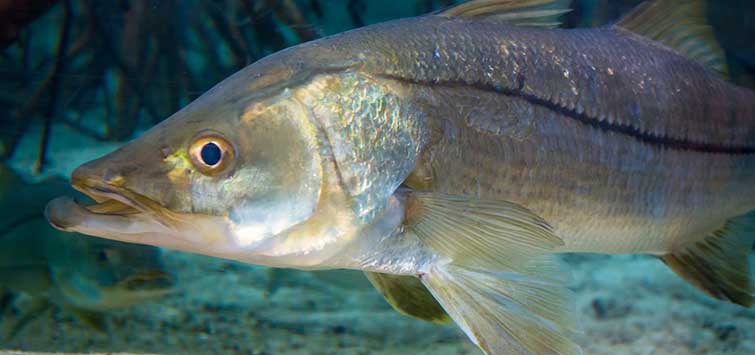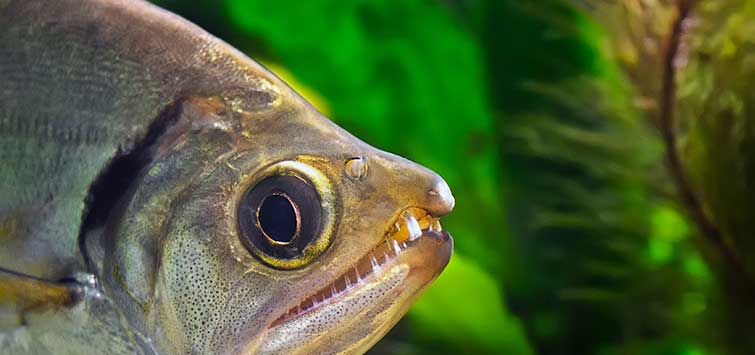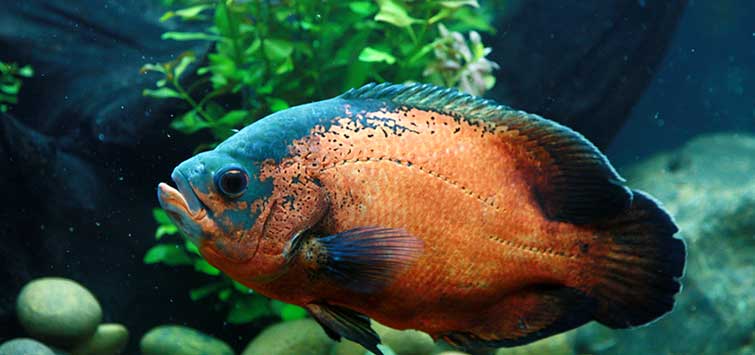Top of the Food Chain: The Swordspine Snook Centropomus ensiferus
Author: Brian M. Scott
During the summer of 2006, while visiting the cichlid breeding facility of close friend and well-known cichlid expert Jeff Rapps, I noticed a shiny dart-like fish that looked like a little snook in one of his holding tanks. “Jeff, what are these” I said. “Oh, those are swordspine snook, cool huh?” he replied. “Heck yeah they are cool!” I said, “where did you get ‘em?”
“Guyana,” he answered. Jeff keeps his sources close to his chest.
Jeff further informed me that it had been nearly a decade since he last saw them on an availability list, and that a close friend of his had requested snook if they ever became available. Jeff only had 10 specimens, all measured about 5 inches in total length (TL). I had to have them—they were just too cool and extremely rare (at the time). Four were promised to the fellow that had requested them initially, but Jeff allowed me to have the remaining six.
The Swordspine
Why do they call this species the “swordspine snook” anyway? Well, one look at the fish and the answer should be clear—the second spine of the anal fin is modified in such a way as it appears as a sword extending from the base of the anal fin. It’s also very sharp, too—trust me!
A Perfect Candidate!
Recognizing that this “new” fish would make a perfect candidate as a topic for my column, I needed to get some experience keeping and researching them before writing. Even though these little snook only grow to about a foot TL as adults, I did not feel that the empty 125-gallon tank I had in mind would house all six of them comfortably. Realizing this, I immediately thought of another close friend, expert fishkeeper Ed Wong. For those of you who read this column regularly you’ll recognize Ed’s name from the fantastic photos that he contributes very frequently (additionally, Ed is the administrator of www.waterwolves.com).
Obviously, Ed has what it takes to house and photograph these fish, so he was my first go-to person when it came to finding a home for three of the fish that I didn’t have the space to keep. It didn’t take much for me to convince Ed that he had to have these fish; the next day, three were on their way to him.
Some Simple Experiences
The three specimens that I kept for myself were very skittish at first, but I should say that they were the only fish in the 125-gallon tank, which was very sparsely decorated and had light-colored pea gravel instead of a dark, more comforting substrate. For those that are wondering why the color of the gravel matters, light-colored gravel tends to make fish a little less comfortable compared to darker-colored gravel.
If you think about it, few aquarium fish species are found in the open, unsheltered areas of their habitat, so the darker tone that a dark substrate produces is generally more soothing to them. This is especially true with flighty or schooling species. Not to mention, I think most fish simply look cooler on dark gravel anyway.
Feeding the new additions was never an issue, as mine ate prepared foods in the form of cut fresh shrimp and fish fillet almost immediately. They consumed enough food to just round out their bellies, and even though I afforded them the opportunity to eat more, they didn’t. Swordspine snook seem to know just when enough is enough. Soon they consumed all manner of offered feeds, including floating krill, large pellets, fresh seafood of various forms, and even pellets. Live fishes were offered and greedily eaten with gusto, but with their seemingly ravenous and not-so-picky appetite I felt little need to chance a disease outbreak by giving them live fishes.
With all of this success (so far) I felt like a new hobbyist yearning to learn everything possible about this new and exciting fish. One thing that I quickly learned from speaking to some old-timers, however, was that this fish was nothing new at all. The wind wasn’t to be knocked from my sails though; I thought they were new, Ed thought they were new, to my fish friends they were new, and since I am still too young to be an “old timer,” they sure are new to me!
Everything Old is New Again
Yes, even in the small, fairly isolated world of tropical fishkeeping, history does in fact repeat itself. Just as with the Pacific tarpon, the swordspine snook was popular way back when. Apparently, they don’t do well in shipping, and combined with the fact that they are freshwater fish and people thought they needed brackish conditions, they perished too often to be a viable candidate for the continued import into the tropical fish markets of the world.
I will admit, while sitting there staring at snook, swordspine or not, in my tank it was difficult for me to refrain from dumping in some sea salt. Snook and salt go together like peas and carrots, but apparently these are a true freshwater species that actually will do very poorly if suddenly added to a system with brackish water in it. According to some folks who I spoke to, they will acclimate to brackish conditions over a brief time. The actual amount of time needed to acclimate to brackish water is not totally clear, and mine continue to be in strict freshwater at the time of this writing—and doing wonderfully in it, too!
I will devote the rest of this column to a very brief overview of some basic information on the swordspine snook. Perhaps down the road, as more hobbyists are now keeping this species, we will see another article with some detailed information about the unique behavior, feeding requirements, and maybe even spawning of this interesting and unique “new” species of predatory tropical fish.
Natural History
The swordspine snook Centropomus ensiferus was described in 1860 by noted taxonomist F. Poey. C. ensiferus belongs to the class Actinopterygii (ray-finned fishes), order Perciformes (perch-like fishes), and family Centropomidae (snooks). It is one of 12 species, all within Centropomus, and is the second smallest member of that genus next to C. robalito (the yellowfin snook)—a distinction sometimes also given to C. armatus (the armed snook).
Natural Habitat
As mentioned, the swordspine snook is a freshwater species that does not do well if housed in a brackish environment. With time and proper acclimation procedures, a brackish setup will suffice for at least brief periods of time. In nature, they certainly are found in brackish estuarine environments, as well as in full-strength marine environments, but they are more often encountered inland, sometimes many miles inland and even in landlocked lagoons and lakes. FishBase (www.fishbase.org) lists their preferred habitat as freshwater or low brackish water and indicates that they are found over soft bottoms. Soft bottoms are those that are primarily mud or sand, and may or may not be devoid of bottom structure, which is why I initially set them up in a tank with no bottom cover. They do, however, enjoy sitting just off the bottom under some overhanging driftwood or plastic plants, where they lie in wait of a passing meal.
Natural Diet
The natural diet of the swordspine snook consists largely of shrimps, other crustaceans, whole fishes, and insects. Insects are more often consumed by young fish, while crabs and larger species of prawns are accepted by older, larger specimens. Whole fishes and shrimps are size-related prey, which are targeted at all stages of growth, and make up close to 90 percent of the snook’s diet. The majority of the foods that I offer my fish contain some form of shrimp or fish substance, whether it is whole, as a meal, or even as chunked meat. I have always felt that replicating an animal’s natural diet gives the keeper a better chance of success with that particular animal—fish and non-fish alike.
Behavior
The swordspine snook is a fairly peaceful species that will usually not harass other fish unless they are in too close of proximity to the snook. This is one more reason that a large aquarium is needed; as they grow, they become more belligerent toward each other as well.
Tankmates should only be considered if the system is large enough for the dithers to escape without harm. The pointed snout of the snook and the speed and force in which they are capable of driving that snout into their targets is something to be reckoned with. It is not uncommon for the swordspine snook to act as a sort of battering ram, and with such a small surface area, that snout really does some damage. Of course, the narrow, flattened snout itself is very capable of getting damaged as well, and such is common with newly imported specimens that often have rubbed their snouts raw on aquarium glass while feeling out the boundaries of their confinement.
Scratching the Surface
The swordspine snook is a truly fascinating species of snook. Their behavior and sheer appearance make them a most enjoyable fish to house in a home aquarium. The information above is a mere base on which further information should be built upon, as there is so much more to say about this wonderful fish.
Acknowledgements
I would like to take a minute and personally thank the following individuals for their assistance with information about the swordspine snook: Jeff Rapps, K. P. Devlin, Ed Wong (information and killer photos!), and the fine members of www.waterwolves.com for the posts and feedback offered on the care and husbandry of this species.
I strongly encourage those of you who really want to give this fish a try to reach out to one of the web forums that specialize in large predatory fishes and whose ads usually appear right here in my column. The members of these forums can offer more first-hand knowledge and perhaps different perspectives that may or may not work for you in your swordspine snook endeavors. Additionally, it’s really a lot of fun to chat with people from all over the world who share the same interests when it comes to tropical fishes for home aquariums.
Good luck and best fishes to all!

.png?h=595&iar=0&w=2781&hash=5FD5E69473BCC22199FBFA2FB71B6033)



